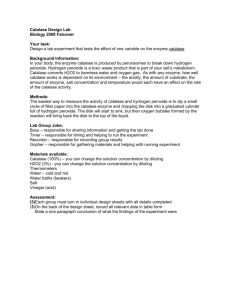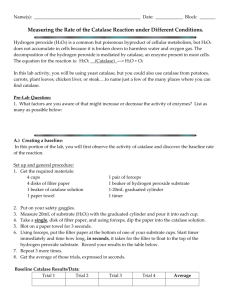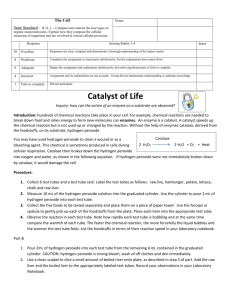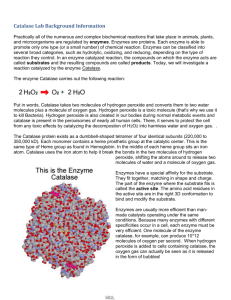Catalase to the Rescue
advertisement
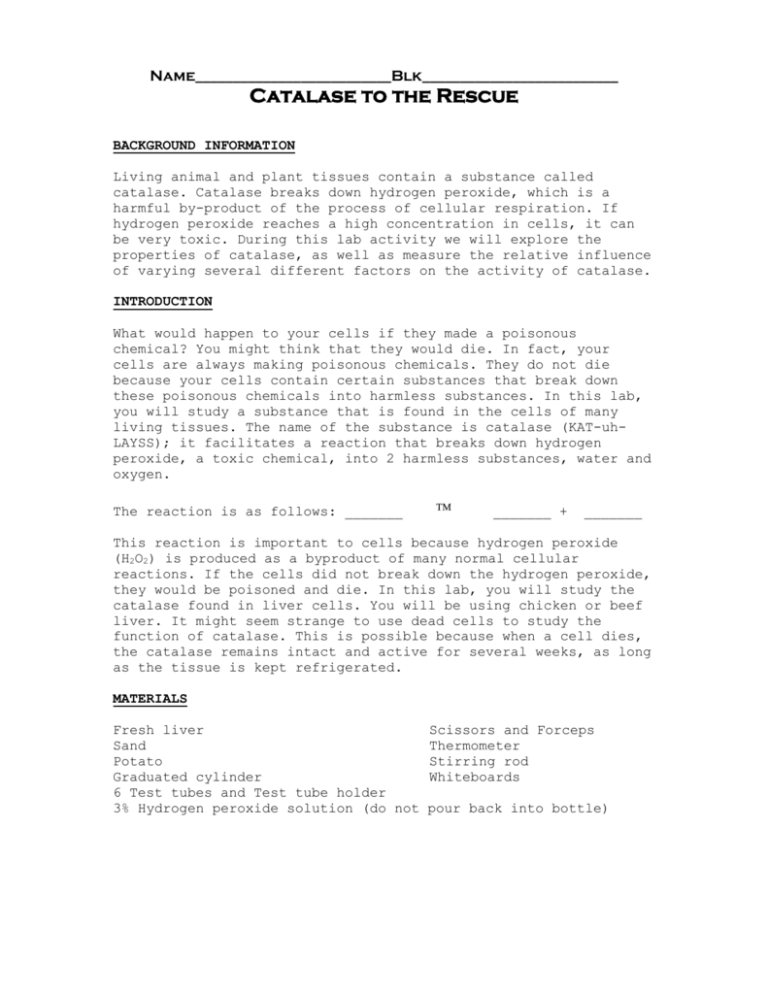
Name__________________________Blk__________________________ Catalase to the Rescue BACKGROUND INFORMATION Living animal and plant tissues contain a substance called catalase. Catalase breaks down hydrogen peroxide, which is a harmful by-product of the process of cellular respiration. If hydrogen peroxide reaches a high concentration in cells, it can be very toxic. During this lab activity we will explore the properties of catalase, as well as measure the relative influence of varying several different factors on the activity of catalase. INTRODUCTION What would happen to your cells if they made a poisonous chemical? You might think that they would die. In fact, your cells are always making poisonous chemicals. They do not die because your cells contain certain substances that break down these poisonous chemicals into harmless substances. In this lab, you will study a substance that is found in the cells of many living tissues. The name of the substance is catalase (KAT-uhLAYSS); it facilitates a reaction that breaks down hydrogen peroxide, a toxic chemical, into 2 harmless substances, water and oxygen. The reaction is as follows: _______ _______ + _______ This reaction is important to cells because hydrogen peroxide (H2O2) is produced as a byproduct of many normal cellular reactions. If the cells did not break down the hydrogen peroxide, they would be poisoned and die. In this lab, you will study the catalase found in liver cells. You will be using chicken or beef liver. It might seem strange to use dead cells to study the function of catalase. This is possible because when a cell dies, the catalase remains intact and active for several weeks, as long as the tissue is kept refrigerated. MATERIALS Fresh liver Sand Potato Graduated cylinder 6 Test tubes and Test tube holder 3% Hydrogen peroxide solution (do not Scissors and Forceps Thermometer Stirring rod Whiteboards pour back into bottle) PROCEDURE For each question below you should make a prediction and describe your reasoning. Then describe your setup and explain the reasoning behind your experimental design. You need to do this first on the whiteboard to show your teacher before proceding to the experiment. ASK QUESTIONS! BE PREPARED TO SHARE YOUR DESIGN AND DATA WITH THE CLASS. PART A Focus Question: What substances provided (liver, potato, sand) contain catalase? Prediction: Reason for prediction: Procedure: Results: Next step? PART B Focus Question: What causes the reaction between catalase and hydrogen peroxide to stop? Prediction: Reason for prediction: Procedure: Results: Next step? PART C Focus Question: What is the effect of temperature on catalase activity? Prediction: Reason for prediction: Procedure: Results: Next step? PART D Focus Question: What is the effect of pH on catalase activity? Demonstration: REFLECTION & DISCUSSION QUESTIONS Name________________ Part A A. What substances you tested were organic? Inorganic? B. How are the substances the same? How are they different? C. What factor(s) are you relying on to make conclusions in part A? Part B A. What could cause the reaction to stop? What is your conclusion? Explain. B. Based on your data, is catalase reusable? Part C A. What seems to be the effect of temperature on catalase activity? Explain. Part D A. What seems to be the effect of pH on catalase activity? Explain. B. Based on your data from part C and D, why do YOU think environmental factors sometimes influence catalase activity? 1. What is the source of the catalase in this lab? 2. Based on your data, is catalase only found in living tissues? 3. What type of substance is MnO2? Is it a source of catalase? 4. Why is hydrogen peroxide used by humans as a tool against infection? 5. If you could do the lab again, would you modify your experimental design in the attempt to better answer any of the focus questions? Explain. DATA TABLE PART (A,B,C,D) REACTANTS OBSERVATIONS (RATE OF REACTION)

